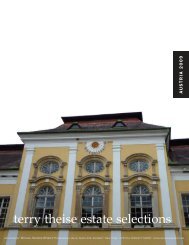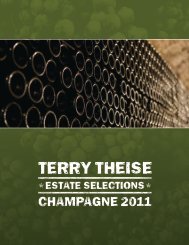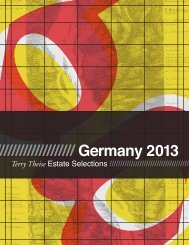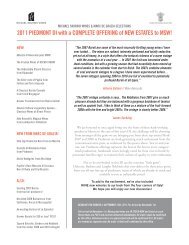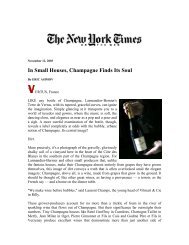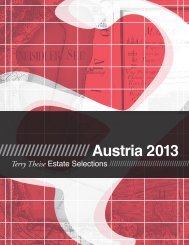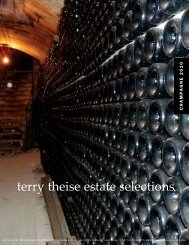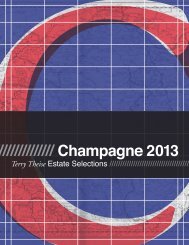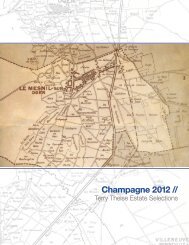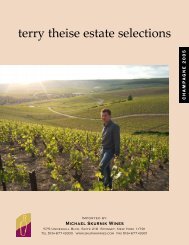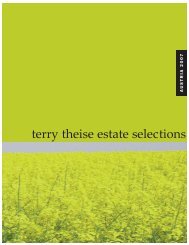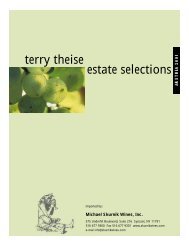German Catalog 2006 USE THIS ONE.qxp - Michael Skurnik Wines
German Catalog 2006 USE THIS ONE.qxp - Michael Skurnik Wines
German Catalog 2006 USE THIS ONE.qxp - Michael Skurnik Wines
You also want an ePaper? Increase the reach of your titles
YUMPU automatically turns print PDFs into web optimized ePapers that Google loves.
schlossgut diel<br />
nahe • burg layen<br />
This year I want to broaden the offering. Some of the new items are still awkwardly priced in<br />
this weak-Dollar era (can’t Armin Diel use his considerable influence and resourcefulness with<br />
the central banks?? I mean, after all . . .) but I’m showing more of the range as a kind of tribute.<br />
It is very rare indeed to encounter a domain whose work is marked by such consistent intelligence<br />
across a variety of styles. It brings Bründlmayer to mind, actually, and not at all because<br />
Diel’s cellarmaster Christof Friedrich has a voice identical to Willi Bründlmayer’s.<br />
Armin Diel believes 2005 is the greatest vintage in his estate’s history. Yes, he said the same<br />
about 2003. So OK, `03 becomes the 2nd-best vintage in the estate’s history. Ten, fifteen, twenty,<br />
thirty years from now I’ll meet you there and we can see<br />
which one really delivers the goods. Me, I just hope I get<br />
to drink plenty of both. And I sense 2005 will, at every<br />
point of its life, show just a little more vinosity and thickness,<br />
and that 2003 will evolve an even more exquisite,<br />
pure fruit.<br />
I don’t deal in a prioris, and I’m a lousy tactician. I<br />
never sat down and said “I will make a specialty of catching<br />
the rising stars before anyone knows them,” yet in<br />
many cases this is what I’ve done. Dönnhoff, Hexamer,<br />
Rumpf, Weingart, Catoir, Meßmer, Leitz, Spreitzer,<br />
Christoffel, Schaefer, Adam (if he opts to continue!),<br />
Karlsmühle; all were relatively “obscure” when I began<br />
importing their wines, and all are Big Names now. This is<br />
satisfying because I share-at least a tiny part-in the<br />
achievement.<br />
Thus my representing<br />
Schlossgut Diel constitutes<br />
a departure, and<br />
will ramify in unpredictable<br />
ways. For it’s the<br />
first time a superstarestate<br />
has entered this<br />
portfolio with its reputation<br />
already established.<br />
The first thing to tell<br />
you is: the wines are stellar.<br />
That’s not a word I<br />
casually throw around.<br />
Schlossgut Diel belongs<br />
in the class of the elite.<br />
The wines will wow you.<br />
Armin occupies an<br />
unprecedented position<br />
in the wine world. He is<br />
proprietor of his estate<br />
on the Nahe, and he is<br />
perhaps the most influ-<br />
Armin Diel<br />
ential wine writer in<br />
<strong>German</strong>y. Imagine if Bob<br />
Parker owned one of the 1st-Growth Bordeaux: just like<br />
that. Needless to say neither Armin nor his colleagues<br />
•Vineyard Area: 17 hectares<br />
•Annual Production: 10,000 cases<br />
•Top Sites: Dorsheimer Goldloch,<br />
Pittermännchen and Burgberg<br />
•Soil Types: loam and gravel over rocky<br />
subsoil, quartzite and slate<br />
•Grape Varieties: 65% Riesling,<br />
20% Grauburgunder, 10% Spätburgunder,<br />
5% Weissburgunder<br />
writing for the same books or magazines review the<br />
wines of Schlossgut Diel, which is why the name doesn’t<br />
appear on the various lists of estate “classifications.” But<br />
of course there’s a meta-message: “The man is such an<br />
expert, imagine how good his own wines must be.” The<br />
ethics of the situation are quite sophisticated to American<br />
sensibilities, yet behind it all are the wines themselves.<br />
The rieslings hail most importantly from a trio of contiguous<br />
Grand Crus: Goldloch on thin loam and gravel<br />
over a rocky subsoil, Burgberg on quartzite, and<br />
Pittermännchen on Hunsrück slate. “The age of the vines<br />
are similar in the three sites, the microclimates are similar<br />
in the three sites, only a few meters separate them from<br />
one another, yet they are entirely different based on terroir,”<br />
say Armin and his cellar-master Christoph Friedrich.<br />
These two have an admirably close working relationship.<br />
Indeed it’s a pleasure to see the penetration and flexibility<br />
of their mutual intelligence. Of course we rapped<br />
about the usual wine stuff, but at one point Armin interrupted<br />
to say “We do this and we do that, but most<br />
important is that all indications are in question every<br />
year, there is no monolithic recipe to ‘make’ wines year<br />
by year. Each vintage asks different questions than the<br />
previous one. I’m really thrilled to have a sensible guy<br />
like Christoph who can play in both major and minor<br />
keys.” Quite so. In effect there is very little in the “hard”<br />
117<br />
NAHE WINES



